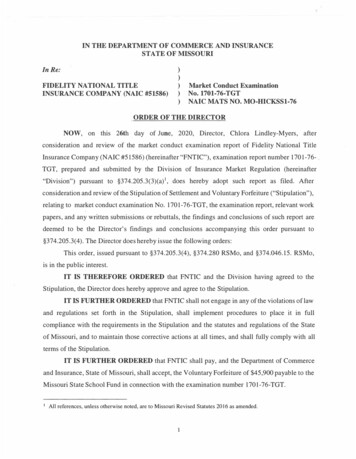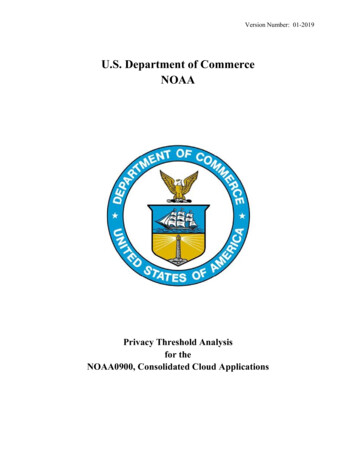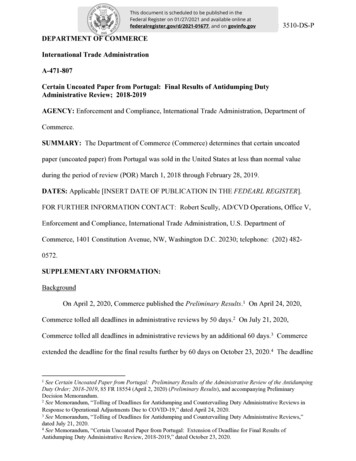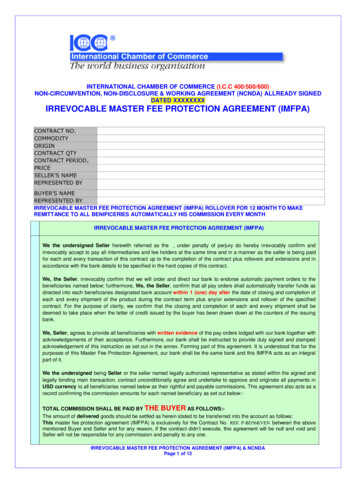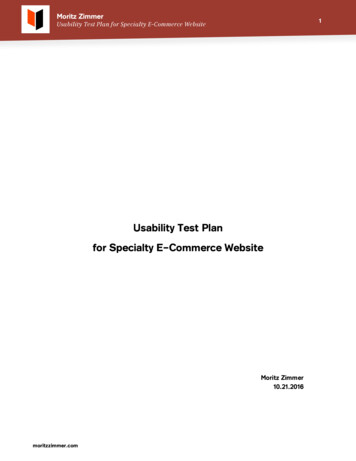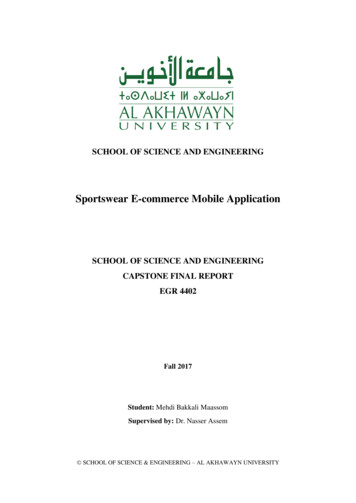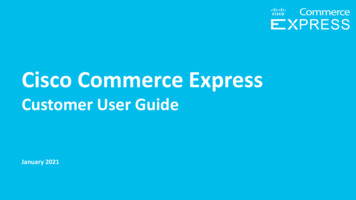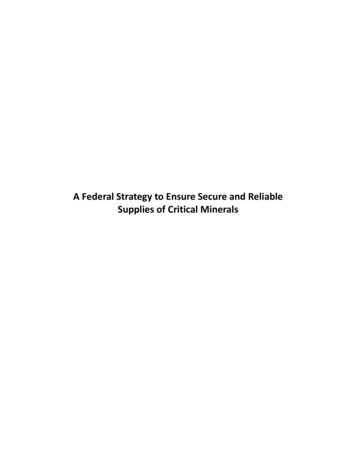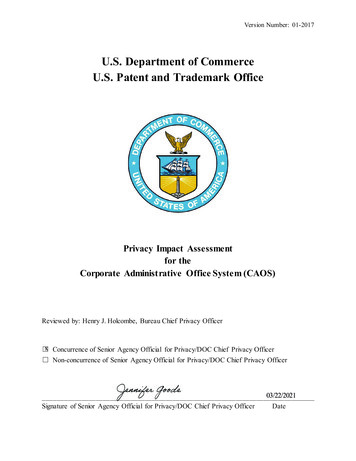
Transcription
Version Number: 01-2017U.S. Department of CommerceU.S. Patent and Trademark OfficePrivacy Impact Assessmentfor theCorporate Administrative Office System (CAOS)Reviewed by: Henry J. Holcombe, Bureau Chief Privacy Officerx Concurrence of Senior Agency Official for Privacy/DOC Chief Privacy Officer ܆ ܆ Non-concurrence of Senior Agency Official for Privacy/DOC Chief Privacy Officer03/22/2021Signature of Senior Agency Official for Privacy/DOC Chief Privacy OfficerDate
Version Number: 01-2017U.S. Department of Commerce Privacy Impact AssessmentUSPTO Corporate Administrative Office System (CAOS)Unique Project Identifier: PTOC-005-000Introduction: System DescriptionProvide a description of the system that addresses the following elements:The response must be written in plain language and be as comprehensive as necessary to describe the system.(a) Whether it is a general support system, major application, or other type of systemThe Corporate Administrative Office System (CAOS) is an Application information system. Thepurpose of the CAOS is to support the Human Resources business functions within the United StatesPatent and Trademark Office (USPTO).(b) System locationThe CAOS system resides at the USPTO facilities located in Alexandria, Virginia.(c) Whether it is a standalone system or interconnects with other systems (identifying anddescribing any other systems to which it interconnects)CAOS interconnects with following other systems:Enterprise Unix Services (EUS)Enterprise Windows Servers (EWS)Information Delivery Product (IDP)Service Orientated Infrastructure (SOI)Corporate Web Systems(CWS)Database Services (DBS)Enterprise Software Services (ESS)Network and Security Infrastructure (NSI)Enterprise Monitoring and Security Operations (EMSO)(d) The way the system operates to achieve the purpose(s) identified in Section 4Web Time and Attendance Automated System (WebTA) collects and maintains USPTOemployee Social Security numbers to process, personal leave balances; time and attendanceinformation, employee related information, position description and management information.Continuity of Operations Plan Work Book (COOP-WB): Individual COOP officers in the1
Version Number: 01-2017various major Offices and Business Units within USPTO supply information and requirementssupporting emergency Continuity of Operations for the USPTO. COOP-WB collects thenecessary staff/employee resource information such as: names, personal home number, personalcell number, and personal email.Emergency Notification System (ENS) collects and maintains USPTO employee ID, email ID,work and home phone number, work and home address which enables the Office of Security toprovide emergency information and instructions agency-wide or to a targeted building and, whenbeneficial, to receive feedback through responses to the message.Record Sharing Platform (RSP) application presents USPTO employee ID, log in/log out, badgein/badge out details in report format which enables the USPTO supervisors and business unitmanagers to verify the information that is being entered into the USPTO WebTA time reportingsystem.Enterprise Telework Information System (ETIS) collects and maintains USPTO employee ID,email ID, work and home phone number, work and home address/alternative telework addressfor administering Telework programs(e) How information in the system is retrieved by the userWebTA: Allows USPTO employees to record, track, validate and certify their time andattendance. Complete payroll and personal transactions including Statements of Earnings andLeave, quick service payments, final salary payments for indebted employees, payments to theestate of a deceased employee, view and print a USPTO employee’s W-2, and Wage and TaxStatement data.COOP-WB: Allows authorized emergency management personnel and COOP Business Unitmanagers and assistants to input Continuity of Operation information such as business impacts,line of succession, critical IT applications and processes, staff/employee personal information,and more.ENS: The USPTO Emergency Notification System (ENS) provides rapid dissemination ofemergency messages to USPTO personnel and contractors via desktop notifications on and mailmessages to USPTO email accounts. Also, ENS provides a "Self Service" facility where usersmay provide additional mean of contact, such as Cell, Home phone or alternate email which willalso receive the alert.RSP: RSP is used by USPTO employees to view, through a user interface, their badge in/badgeout and log in/log out details.ETIS: ETIS is used by all USPTO Business Units (other than Patents) and offers an easy-toupdate pop-up of employee information, including employee telework applications; seamlesscommunication with HR systems, and history/version controls to track data.2
Version Number: 01-2017(f) How information is transmitted to and from the systemThe information is transmitted to and from the CAOS system using end-to-end secure transportlayer protocols.(g) Any information sharing conducted by the systemWebTA: The information collected is shared with NFC’s automated personnel/payrollprocessing system.COOP-WB: The information collected is shared internally among agency emergencymanagement personnel, COOP Business Unit managers/assistants, and USPTO SeniorManagement.ENS: The information collected is shared internally among agency emergency managementpersonnel.RSP: Information hosted or collected by RSP is only accessible to individual users and RSPadministrators and is not shared with anyone else within USPTO or outside USPTO.ETIS: Information hosted or collected by ETIS is only accessible to respective USPTO businessunits (except Patents) and its employees. The information is not shared with anyone outsideUSPTO.(h) The specific programmatic authorities (statutes or Executive Orders) for collecting,maintaining, using, and disseminating the informationThe information is collected for the purpose of Federal and Federal contract employment undersections 1302, 3301, 3304, 3328, and 8716 of title 5; Executive Order 9397, as amended; andU.S. Code and Federal Continuity Directive-1 (FCD-1). Section 1104 of title 5 allows OPM todelegate personnel management functions to other Federal agencies.(i) The Federal Information Processing Standards (FIPS) 199 security impact category for thesystemWebTA, COOP-WB, RSP, ENS and ETIS: The Sub-system security impact category isModerate.CAOS: The Master System high water-mark security impact category is Moderate.3
Version Number: 01-2017Section 1: Status of the Information System1.1Indicate whether the information system is a new or existing system. ܆ ܆ This is a new information system.This is an existing information system with changes that create new privacy risks.(Check all that apply.)Changes That Create New Privacy Risks (CTCNPR)a. Conversions ܆ d. Significant Mergingb. Anonymous to Non ܆ e. New Public AccessAnonymousc. Significant System ܆ f. Commercial SourcesManagement Changesj. Other changes that create new privacy risks (specify): ܆ ܆ ܈ ܆ ܆ ܆ g. New Interagency Usesh. Internal Flow orCollectioni. Alteration in Characterof Data ܆ ܆ ܆ This is an existing information system in which changes do not create new privacyrisks, and there is not a SAOP approved Privacy Impact Assessment.This is an existing information system in which changes do not create new privacyrisks, and there is a SAOP approved Privacy Impact Assessment (version 01-2015).This is an existing information system in which changes do not create new privacyrisks, and there is a SAOP approved Privacy Impact Assessment (version 01-2017 orlater).Section 2: Information in the System2.1Indicate what personally identifiable information (PII)/business identifiable information(BII) is collected, maintained, or disseminated. (Check all that apply.)Identifying Numbers (IN)a. Social Security* ܈ f.b. Taxpayer ID ܆ g.c. Employer ID ܆ h.d. Employee ID ܈ i.e. File/Case ID ܆ n. Other identifying numbers (specify):Driver’s LicensePassportAlien RegistrationCredit Card ܆ ܆ ܆ ܆ j.k.l.m.Financial AccountFinancial TransactionVehicle IdentifierMedical Record ܈ ܆ ܆ ܆ *Explanation for the business need to collect, maintain, or disseminate the Social Security number, includingtruncated form:WebTA collects and maintains USPTO employee Social Security Numbers (SSN) to process personal leavebalances, time and attendance (T&A) information, employee information, and position description. The T&Ainformation are transmitted to NFC for payroll process using SSN from both WebTA and NFC for identification.There is no way to avoid future collection of SSN. WebTA utilizes SSNs to ensure each employee is associated toa unique identifier and allows for accurate processing of payroll transactions.4
Version Number: 01-2017General Personal Data (GPD)a. Name ܈ h. Date of Birthb. Maiden Name ܆ i. Place of Birthc. Alias ܈ j. Home Addressd. Gender ܆ k. Telephone Numbere. Age ܆ l. Email Addressf. Race/Ethnicity ܆ m. Educationg. Citizenship ܆ n. Religionu. Other general personal data (specify):Work-Related Data (WRD)a. Occupationb. Job Titlec. Work Addressd. Work TelephoneNumber ܆ ܆ ܈ ܈ ܈ ܆ ܆ o.p.q.r.s.t.Financial InformationMedical InformationMilitary ServiceCriminal RecordPhysical CharacteristicsMother’s Maiden Name ܆ ܆ ܈ ܆ ܆ ܆ i. Business Associatesj. Proprietary or BusinessInformation ܆ ܆ ܆ ܆ g. DNA Profilesh. Retina/Iris Scans ܆ ܆ ܆ i.Dental Profile ܆ ܈ ܈ e. ID Files Accessedf. Contents of Files ܈ ܈ ܈ ܈ e. Work Email Addressf. Salary ܈ ܆ ܈ ܈ g. Work Historyh. EmploymentPerformance Ratings orother PerformanceInformation ܆ ܆ k. Other work-related data (specify):Distinguishing Features/Biometrics (DFB)a. Fingerprints ܆ d. Photographsb. Palm Prints ܆ e. Scars, Marks, Tattoosc. Voice ܆ f. Vascular ScanRecording/Signaturesj. Other distinguishing features/biometrics (specify):System Administration/Audit Data (SAAD)a. User ID ܈ c. Date/Time of Accessb. IP Address ܈ d. Queries Rung. Other system administration/audit data (specify):Other Information (specify)2.2Indicate sources of the PII/BII in the system. (Check all that apply.)Directly from Individual about Whom the Information PertainsIn Person ܆ Hard Copy: Mail/FaxTelephone ܆ EmailOther (specify):5 ܆ ܆ Online ܈
Version Number: 01-2017Government SourcesWithin the BureauState, Local, TribalOther (specify): ܈ ܆ Non-government SourcesPublic Organizations ܆ Third Party Website or ApplicationOther (specify):2.3Other DOC BureausForeign ܆ ܆ Other Federal Agencies ܆ Private Sector ܆ ܆ Commercial Data Brokers ܆ Describe how the accuracy of the information in the system is ensured.All System related generic error messages are presented to users while detailed debuggingerror messages are provided to administrators. Error conditions are handled so as not toprovide information that could be exploited by adversaries. Access to the system is onlyassigned to authorized users with specific role based restrictions, and individuals with accessprivileges have undergone vetting and suitability screening. Data is maintained in areasaccessible only to authorized personnel. The USPTO maintains an audit trail and performsrandom periodic reviews to identify unauthorized access.2.4Is the information covered by the Paperwork Reduction Act? ܆ Yes, the information is covered by the Paperwork Reduction Act.Provide the OMB control number and the agency number for the collection. ܈ No, the information is not covered by the Paperwork Reduction Act.2.5Indicate the technologies used that contain PII/BII in ways that have not been previouslydeployed. (Check all that apply.)Technologies Used Containing PII/BII Not Previously Deployed (TUCPBNPD)Smart Cards ܆ BiometricsCaller-ID ܆ Personal Identity Verification (PIV) CardsOther (specify): ܈ ܆ ܆ There are not any technologies used that contain PII/BII in ways that have not been previously deployed.Section 3: System Supported Activities3.1Indicate IT system supported activities which raise privacy risks/concerns. (Check all that6
Version Number: 01-2017apply.)ActivitiesAudio recordingsVideo surveillanceOther (specify): ܈ ܆ ܆ Building entry readersElectronic purchase transactions ܆ ܆ There are not any IT system supported activities which raise privacy risks/concerns.Section 4: Purpose of the System4.1Indicate why the PII/BII in the IT system is being collected, maintained, or disseminated.(Check all that apply.)PurposeFor a Computer Matching ProgramFor administrative mattersFor litigationFor civil enforcement activitiesTo improve Federal services onlineFor web measurement and customizationtechnologies (single-session )Other (specify): ܆ ܈ ܆ ܆ ܈ ܆ For administering human resources programsTo promote information sharing initiativesFor criminal law enforcement activitiesFor intelligence activitiesFor employee or customer satisfactionFor web measurement and customizationtechnologies (multi-session ) ܈ ܆ ܆ ܆ ܆ ܆ Section 5: Use of the Information5.1In the context of functional areas (business processes, missions, operations, etc.) supportedby the IT system, describe how the PII/BII that is collected, maintained, or disseminatedwill be used. Indicate if the PII/BII identified in Section 2.1 of this document is inreference to a federal employee/contractor, member of the public, foreign national, visitoror other (specify).7
Version Number: 01-2017WebTA captures employee Social Security Numbers in order to collect, validate, andelectronically certify time and attendance information. This information is further collectedfor secure transmission over the USPTO network to the National Finance Center (NFC) forpayroll processing. WebTA collects only USPTO employee information.COOP-WB information is to be used only in reporting to the COOP Manager and USPTOSenior Management, and creation of the overall USPTO COOP Workbook. COOP-WBcollected information is used to support emergency Continuity of Operations for the USPTO.Both USPTO employee and contractor information is collected from those personnel withemergency Continuity of Operations responsibilities.ENS collected information enables the Office of Security to provide emergency informationand instructions agency-wide or to a targeted building and, when beneficial, to receivefeedback through responses to the message. Both USPTO employee and contractorinformation is originally collected from those personnel at the time of onboarding.ETIS collects PII, such as name, home address, and telephone number of USPTO employeesand public data, such as work ID, location, email, telephone number, etc, to file and managetelework applications.RSP application uses USPTO employee ID, log in/log out, badge in/badge out details andpresents it in report format which enables the USPTO supervisors and business unit managersto verify the information that is being entered into the USPTO WebTA time reporting system.5.2Describe any potential threats to privacy as a result of the bureau’s/operating unit’s use ofthe information, and controls that the bureau/operating unit has put into place to ensurethat the information is handled, retained, and disposed appropriately. (For example:mandatory training for system users regarding appropriate handling of information,automatic purging of information in accordance with the retention schedule, etc.)The scope of potential threat to privacy is internal to USPTO. CAOS implements security andmanagement controls to prevent the inappropriate disclosure of sensitive information.Management controls are utilized to prevent the inappropriate disclosure of sensitiveinformation including Annual Security Awareness Training which is mandatory for allUSPTO employees. It includes training modules on understanding privacy responsibilitiesand procedures and other information such as defining PII and how it should be protected.Security controls are employed to ensure information is resistant to tampering, remainsconfidential as necessary, and is available as intended by the agency and expected by users.USPTO implements automatic purging of information, as applicable, by means of deletionand/or shredding. In addition, the Perimeter Network (NSI) and EMSO provide additionalautomated transmission and monitoring mechanisms to ensure that PII information isprotected and not breached by any outside entities.Section 6: Information Sharing and Access6.1Indicate with whom the bureau intends to share the PII/BII in the IT system and how thePII/BII will be shared. (Check all that apply.)RecipientHow Information will be Shared8
Version Number: 01-2017Within the bureauDOC bureausFederal agenciesState, local, tribal gov’t agenciesPublicPrivate sectorForeign governmentsForeign entitiesOther (specify): ܆ 6.2 ܈ ܆ 6.3Case-by-Case ܈ ܆ ܈ ܆ ܆ ܆ ܆ ܆ ܆ Bulk Transfer ܈ ܆ ܈ ܆ ܆ ܆ ܆ ܆ ܆ Direct Access ܈ ܆ ܆ ܆ ܆ ܆ ܆ ܆ ܆ The PII/BII in the system will not be shared.Indicate whether the IT system connects with or receives information from any other ITsystems authorized to process PII and/or BII.Yes, this IT system connects with or receives information from another IT system(s) authorized toprocess PII and/or BII.Provide the name of the IT system and describe the technical controls which prevent PII/BII leakage:WebTA interconnects with the Department of Agriculture’s National Finance Center (NFC) for payrollprocessing. All data transmissions require credential verification and validation of data prior totransmitting. The data passes through a dedicated interconnection (IPSec VPN tunnel) established withNFC.COOP-WB information will be shared internally to the COOP Office and with USPTO SeniorManagement (via reports and the overall Workbook).COOP-WB information is protected withinUSPTO’s secure perimeter through the Network and Security Infrastructure (NSI) system.ENS information will be shared internally to the agency emergency management personnel and withUSPTO Senior Management. ENS information is protected within USPTO’s secure perimeter throughThe Network and Security Infrastructure (NSI) system.ETIS information will be shared internally to the ETIS management personnel and with USPTOSenior Management. ETIS information is protected within USPTO’s secure perimeter through theNetwork and Security Infrastructure (NSI) system.RSP information will be shared internally to the Human Resources management personnel and withUSPTO Senior Management. R information is protected within USPTO’s secure perimeter throughThe Network and Security Infrastructure (NSI) system.No, this IT system does not connect with or receive information from another IT system(s) authorized toprocess PII and/or BII.Identify the class of users who will have access to the IT system and the PII/BII. (Checkall that apply.)Class of UsersGeneral PublicContractorsOther (specify): ܆ ܈ Section 7: Notice and Consent9Government Employees ܈
Version Number: 01-20177.1 ܈ ܈ Indicate whether individuals will be notified if their PII/BII is collected, maintained, ordisseminated by the system. (Check all that apply.)Yes, notice is provided pursuant to a system of records notice published in the Federal Register anddiscussed in Section 9.Yes, notice is provided by a Privacy Act statement and/or privacy policy. The Privacy Act statementand/or privacy policy can be found at:CAOS: https://www.opm.gov/forms/pdf fill/of0306.pdf and USPTO’s internal IT Privacy Policy(for business use only). ܆ Yes, notice is provided by other means. ܆ No, notice is not provided.7.2Specify why not:Indicate whether and how individuals have an opportunity to decline to provide PII/BII. ܈ Yes, individuals have an opportunity todecline to provide PII/BII. ܆ No, individuals do not have anopportunity to decline to providePII/BII.7.3Specify how:Specify how:CAOS: PII data is collected as part of the employment processthrough OMB Form 3206-0182. Applicants can decline toprovide their information, however, in d
Mar 22, 2021 · Enterprise Software Services (ESS) Network and Security Infrastructure (NSI) Enterprise Monitoring and Security Operations (EMSO) (d) The way the system operates to achieve the purpose(s) identified in Section 4 Web Time and Attendance
